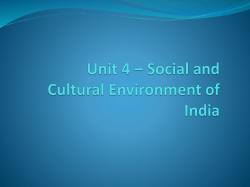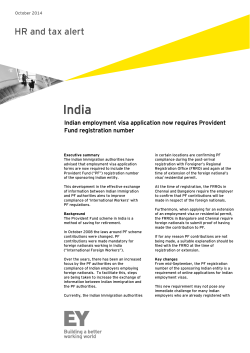
Chapter 8 From Raga to Bollywood: Developments and Intercultural Crossings in Indian Music
Chapter 8 From Raga to Bollywood: Developments and Intercultural Crossings in Indian Music Introduction Two perspectives on Indian music are explored in this unit: the Hindustani raga tradition and the modern history of Indian/Western intercultural musical encounters. Key words: Barhat –refers to the note-by-note expansion of the melodic range of a raga during performance. Also applies to cultural growth and the experience of musicians. Gharana – “musical families” that have preserved and developed schools of raga performance in India, often throughout generations. Indian Music in Context India has a diverse population: 200+ languages; 1,600 dialects. In 1500 BCE, the indigenous population was pushed south. This may be the root of the north/south division (Hindustani/Karnatak). Indian classical music and the Hindu religion have close ties, as in the bhajan devotional songs and hymns. In the 5th c. BCE, Buddhism and Jainism originated in India. Islam was introduced in the 8th c. CE. Hindus and Muslims have formed many bonds through culture, including music. Sufism, a mystical form of Islam, features music as a pathway to the divine. CD ex. #2-20 features vocalist Shafqat Ali Khan in the performance of a Sufi devotional song. This style of music is distinct from but related to the Sufi musical style called qawwali, which gained considerable international popularity through the late qawwali superstar Nusrat Fateh Ali Khan. European influence on India began in the 15th century when the Portuguese, French, Dutch, and English arrived for spice trade. Christianity was imported with limited success. Britain became the dominant colonial power in 1858. India achieved national independence in 1947. After much bloodshed, two largely Muslim areas in the north became Pakistan and East Pakistan. India is officially secular, but over 80% of the population is Hindu. Musical Diversity and Two Great Traditions India is exceptionally diverse musically, as it is culturally. Film song is the dominant popular music. The fan base for film songs from industries like Bollywood extends to millions and millions of people, in India and beyond. Bhangra is a major component of Bollywood music, and features folk songs and dances accompanied by a large drum (dhol) and rhythmic shouts. CD ex. #1-22 features the bhangra tune “Kudi Kudi.” Notice the dhol drumming, electronic drum grooves, synthesizers, and syncopated shouts of “hoi!” There are two main traditions of Indian classical music, the Karnatak of the south and the Hindustani of the north. The Hindustani tradition is more well known globally due to the popularity of Ravi Shankar and general Indian immigration patterns. Differences and similarities between the two traditions are due to political histories, differences in languages, religious ideas, and local cultures. Both traditions build on complex melodic systems called raga and employ rhythmic and metric systems called tala. Singing is viewed as the highest form of musical expression. It is thought to be the sound closest to Nada Brahma, the “Sound of God.” This is the divine source of all music. Standard instrumental ensembles in both traditions include instrumental trios, which feature a single-line melody, drone, and rhythmic accompaniment. Karnatak: vina (melodic), tambura (drone), and mrdangam (rhythmic). Hindustani: sitar (melodic), tambura (drone), tabla (rhythmic). The Hindustani Raga of Northern India Ravi Shankar is the most well-known representative of the Hindustani raga tradition internationally. He encountered Western musicians like the Beatles and influenced many synergistic musical productions. The recordings by John Coltrane, John McLaughlin and Shakti, Bombay Dub Orchestra, and A. R. Rahman included on your CD set illustrate various dimensions of Shankar’s direct and indirect influences on ragainspired intercultural music making. Ravi Shankar and the Maihar Gharana The only Indian musician “to have become a household name in the West.” (Farrell) Was born into the priestly Brahman caste in 1920 and joined a music-anddance troupe while still in his teens. He toured Europe as a sitar player and dancer, befriending classical violinist Yehudi Menuhin along the way. In Europe, he met the raga master Allaudin Khan and later returned to become a musical disciple of Khan (also known as Baba.) Shankar spent some eight years as a musical disciple of Baba, who became his guru; Shankar part of the Maihar Gharana established by Baba. Shankar is known as one of the great sitar masters, and his interactions with George Harrison of the Beatles gave him global superstar celebrity. Two of Shankar’s daughters are also musicians: Anoushka Shankar is, like her father, a sitarist; Norah Jones is a highly successful jazz and popular music singer and songwriter. Insights and Perspectives The Caste System in India India has traditionally recognized a caste system, which divides society into social classes based on family birthright or occupational specialization. Efforts to eradicate the caste system are inspired by concerns about the lowest caste, the Dalit, or “Untouchables.” They have been subject to many abuses and limited opportunities. The caste system is legally banned, but survives in many areas of social and cultural life. The five castes are: Brahmin (priest), Kshatriya (warrior), Vaishya (merchant), Shudra (peasant), and Dalit (untouchable.) Insights and Perspectives The Gharana The gharana is the social institution through which the knowledge of raga is passed through generations. Gharana is sometimes translated as “musical family,” but does not require blood or marriage between members. Members of the gharana trace their heritage through their own guru, the guru’s guru, and so forth to the founder of the gharana. Like the ragas they teach, gharanas develop through a process of growth. Each generation and each member is like a branch of leaf on the gharana “tree,” blossoming from the same root. Insights and Perspectives Anoushka Shankar: Carrying on the Legacy Anoushka Shankar is the only classical sitarist trained exclusively by Ravi Shankar. Like her father, she has charisma, talent, and eclectic musical interests. Her chart-topping CDs include Rise (2005) and Breathing Under Water (2007). “An Introduction to Indian Music” CD ex. #2-21, the Musical Guided Tour track for this unit, introduces the art of Hindustani raga through a lecture demonstration by Ravi Shankar. Follow along with the transcript on page 127. Listen for: The melodic forms of the raga “scale.” The melodic ornaments and microtones. The distinctive sound of the drone. The beat-counts of the talas. Musical Guided Tour “An Introduction to Indian Music” Follow along with the transcript on page 127 of the text as you listen to the audio Tour for this chapter, which is CD ex. #2-21 of the text’s accompanying 4-CD set. The Sitar-Tambura-Tabla Trio This is one of many ensembles used in Hindustani music, but is known on an international scale due largely to the influence of Ravi Shankar. Sitar It is a long-necked, plucked chordophone with a woodcovered half-gourd body. The neck is scalloped, allowing notes to be ornamented by “bending” the strings. Has 6-7 main strings for melody and drone tones, plus 13 sympathetic resonance strings. Tambura It is dedicated specifically to droning. It has four or five strings with thin, sympathetic strings running underneath. It is held vertically in the player’s lap and plucked continuously to produce a wavelike timbral effect. Tabla It is a pair of single-headed drums played by one player. The higher drum, played by the right hand, is the dahina (or tabla.) The lower, left-hand drum, is the bayan, and is usually made of metal. A thick “weight spot” affixed to both goatskin heads allows for a large range of distinctive timbres. Insights and Perspectives Muslim Musicians in Hindustani Musical Society “Interfaith” musical partnerships are common in the Hindustani musical world. One of Ravi Shankar’s greatest tabla accompanists was Alla Rakha, a Muslim musician. Although orthodox forms of Islam view music within religious contexts as suspect, Sufism views musical activity as a pathway to God. Sufism is widely practiced in India and its influence has had much to do with the cross-pollination of Hindu and Muslim cultures in Hindustani music. Other Hindustani Melodic Instruments Sarod: a plucked chordophone. It has a shorter neck than the sitar, has no frets, and has a body covered with animal hide. Bansuri: a bamboo flute prized for its voice-like timbre. Shahnai: an oboe-like instrument. Sarangi: a bowed chordophone. Raga Defined Ragas are “precise melody forms,” and each is a complete and self-contained melodic system that serves as the basis for melodic materials of any performance in that raga. Features include: An identifying set of pitches, like a scale. A unique repertoire of melodic ornaments and melodic motives. A system of rules and procedures. A repertoire of set compositions. A host of extramusical associations, for example, with times of day, seasons, or emotions. Tala: Meter and Rhythm in Raga Performance The tala is the rhythmic framework of a raga performance, and includes the metric cycle in which the music is grounded. Talas range in length from simple cycles of 3 or 4 beats to complex ones of 100+ beats. Various beats of the tala receive different degrees of emphasis. Insights and Perspectives Standard Features of a Tala Summarized Each tala has a specific number of beats. The metric cycle has specific patterns of stronger and weaker beats. The basic, “skeletal” drumming pattern that defines the tala is called the theka. The first beat of each tala cycle, which is also the last beat of the preceding cycle, is called sam. How a Raga “Grows” A raga’s growth in performance is described in terms of its barhat, or growth. Like a growing seed containing all of the directions to become a plant, a raga contains rules for creating a self-contained musical world. Unlike a Western piece of music, a raga is a template for musical action developed through many years of study and practice. Master musicians like Ravi Shankar both adhere to a given raga’s rules and push them to their limits in performance. Form in Raga Performance Generally speaking, raga performances start with slow and abstract motion and become progressively faster and more metrical, ultimately accelerating to a very fast conclusion. This process of increasing speed is symbolic of the growth process (barhat) common to much Indian music. There are several successive formal sections that occur without pauses between them: alap, jor, gat, and jhala. The alap is the slow, abstract, improvised introduction. It is an exploration of the raga’s melodic essence and range, and there is no drumming or meter. The alap is the true test of the improvisatory skill of the performer. The jor is an intermediary section that bridges the alap and the gat. The solo melodic instrument becomes more rhythmic and energetic, but there is not yet a metric cycle (tala) or drumming. The gat begins when the drums enter. The drumming establishes the tala, which serves as the foundation for the remainder of the performance. As the gat proceeds, there is a gradual increase in tempo and patterns/sections become increasingly complex. The jhala drives the performance to an exciting conclusion. It often begins with an upward jump in tempo and energy, and continues to accelerate until the end. CD ex. #2-23 is a raga performance featuring Ravi Shankar that illustrates raga form and aesthetics. It is discussed and summarized on pages 138-42 of the text. Insights and Perspectives Two Kinds of Time In addition to the dimension of time’s passing represented by the gradual and continuous growth of a raga in performance, there is a second type of time, cyclic time, that is represented by the continual recurrence of the tala cycle (i.e., in the gat and the jhala, not the alap or jor). As the raga progresses, time thus becomes manifest in two dimensions: progressive and cyclic. Keeping Tal with Ravi Shankar Keeping tal is a method of clapping, touching fingers, and waving hands to keep time with the music as the musicians play. It is akin to tapping one’s feet to the music’s beat, but more complex; different gestures (claps, finger touches) represent beats of different strength. Tintal, a 16-beat metric cycle, has a handclap on beats 1, 5, and 13; a wave on beat 9, and finger touches on all other beats. Tintal Counting Pattern 1 2 3 4 5 6 7 8 9 10 11 12 13 14 15 16 X - - - x - - - O - X : claps O : wave - : finger touches - - x - - - Insights and Perspectives The Rhythm of Tihai The rhythmic pattern of the tihai is irregular, which creates a syncopated effect and a sense of rhythmic “dislocation.” This forms a growing tension that is finally resolved when all comes together on the final note of the performance. Musicians carefully control the length of the tihai to ensure it lands where it is supposed to. Intercultural Crossings and Transformations Ravi Shankar’s wide-ranging influences and impact have affected cross-cultural developments in the worlds of Western classical, jazz, and rock music, as well as in Bollywood film music of India. The chapter covers some but not all dimensions of Indian/Western intercultural encounters in music. Some topics not covered include non-Indian music conservatories that teach Indian classical music, non-Indian musicians who have studied in India, and music in South Asian diasporic communities in the West. Early Inroads Ravi Shankar’s collaborations with violinist Yehudi Mehuhin throughout the 1950s made him well-known by the 1960s. Shankar acknowledged some similarities between raga and jazz, namely their shared emphases on virtuosity and improvised solos. He collaborated with several prominent American jazz musicians like flutist Bud Shank. In 1961, John Coltrane recorded “India” (CD ex. #3-1). Coltrane had spent much time studying Shankar’s recordings. Although he never recorded with him, he named his own son Ravi. Ravi Shankar, the Beatles, and the “Great Sitar Explosion” Ravi Shankar, the Beatles, and the “Great Sitar Explosion” George Harrison began to teach himself sitar during the filming of the Beatles movie Help!, and featured the instrument on the song “Norwegian Wood” (1965). The sitar suddenly reached millions of new listeners. In 1966, Harrison began studies with Shankar; raga-like features figured prominently on “Within You, Without You,” from Sergeant Pepper’s Lonely Hears Club Band (1967). The sitar soon became a favored “exotic” sound and was used by many bands, including the Byrds, the Yardbirds, and the Rolling Stones. “Sitar rock” had become part of popular music, but most rock and pop musicians did not have the technical ability, nor the musical knowledge, to deeply absorb raga or other Indian features into their music. Ravi Shankar often found the trite and gratuitous use of Indian musical devices disturbing, especially the equation of Indian culture with drug-induced, altered states of consciousness. A New Level: John McLaughlin and Shakti A New Level: John McLaughlin and Shakti In the late 1960s, British jazz guitarist John McLaughlin moved to New York, where he joined Miles Davis’s band. McLaughlin combined his interests in Western classical music, blues, flamenco, jazz, rock, and Indian classical music. He, too, took lessons with Ravi Shankar and later converted to Hinduism. In 1975, he formed the Indian-jazz group Shakti. Aside from McLaughlin, all members were Indian classical musicians by training. CD ex. #3-2 features “Joy,” performed by Shakti, which is discussed and summarized on pages 147-48. Bollywood and Beyond Bollywood and Beyond A. R. Rahman is one of the most renowned and influential Indian musicians on an international scale since Ravi Shankar. He is the preeminent composer and music director in contemporary Indian cinema. In India, film music is dominant over other genres in terms of popularity. Rahman’s success has made him an enormous presence in contemporary Indian music. A. R. Rahman achieves balance between adherence to traditional Indian music elements and pushing Indian music to the outer reaches of global inclusiveness. Rahman experienced an early passion for qawwali, and later adopted Islam as his faith. “I’m a deeply spiritual person. Sufism is about love—love for a fellow human, love for allaround humanity, and ultimately love for God. For me, it’s where music and religion meet… That’s my inspiration.” (Shubhash 2010) Rahman’s stardom went global with the 2008 international hit film Slumdog Millionaire, which won eight Academy Awards. His other films include The Couples Retreat and 127 Hours, and his compositions are featured in Inside Man, Intervention, The Accidental Husband, Elizabeth: The Golden Age, and Lord of War. CD ex. # 3-3 features “Barso Re,” which is discussed and summarized on pages 150-54. This song is from Rahman’s soundtrack for the popular Bollywood film Guru.
© Copyright 2025









